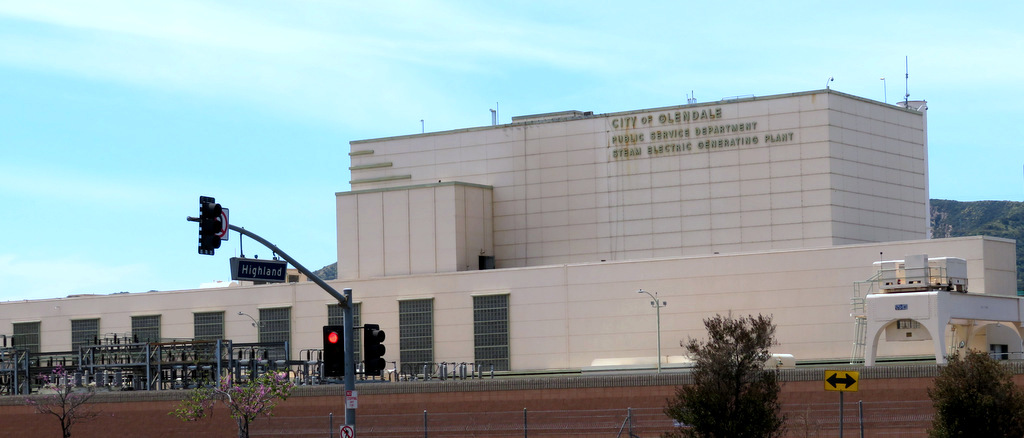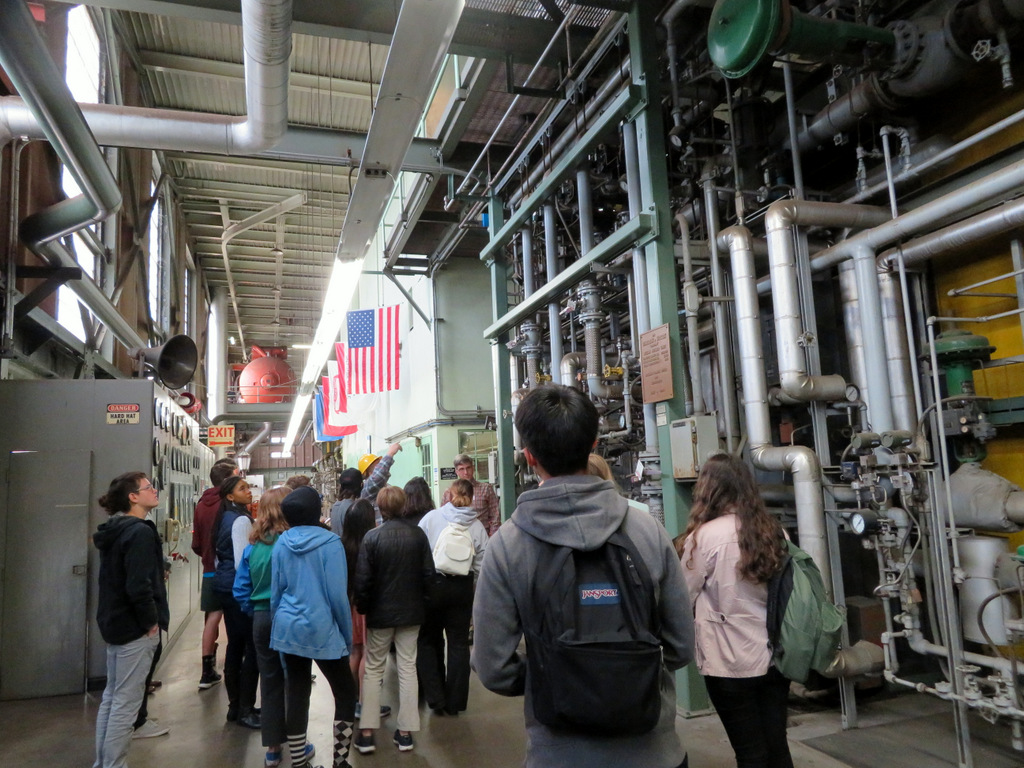I recently had the honor to write an update on Glendale’s plans for repowering its ancient Grayson power plant and the community’s response and fight to make sure it’s California’s last gas plant.
Read my local reporting in the Crescenta Valley Weekly ~ the Grayson story here: Insights Offered at Grayson Tour and check out my cool tour pictures below! (I could listen to people talk about their work all day!) (See the pink donut box?)

Insights Offered at Grayson Tour
The plan for repowering Glendale’s Grayson power plant to be presented by Glendale Water & Power (GWP) to the utility’s citizen commission and the City Council this summer will look considerably different than the plan GWP staff envisioned when first planning for the repowering of the local energy site.
In spring 2017, Dan Brotman, a semi-retired economics professor who says he’s been long involved in advocating for the environment, took note of the City’s plans to repower the Grayson plant using natural gas rather than renewable energy. He wrote an op-ed in April 2017 to make the case against the City’s plan, focusing on both the environmental and financial aspects of his concerns, and then he organized the Glendale Environmental Coalition. By April 2018, more than 500 people protested outside Glendale City Hall, arguably the largest demonstration in Glendale municipal history, and the City Council voted overwhelmingly to pause the proposed repowering project to look at alternatives.
“The environmental arguments are obvious,” Brotman explained. “They were proposing a larger plant than the one they were replacing and, while they may say they’re tripling the energy production but not tripling emissions, the entire process of using gas is environmentally flawed, storing it at Aliso Canyon, methane leaks all along the distribution path; that’s a potent greenhouse gas. Why build another gas plant – perhaps the state’s last licensed gas plant – when the City’s needs can be met using renewables? Why wouldn’t we do that first? And why build such a large gas plant, beyond the actual needs of the City?”
Brotman said that when he scoured the City’s reports and documents he discovered that they had plans to sell excess energy generated by the plant.
“They were planning on creating extra pollutants to make money,” he said.

California state law now requires that renewable energy and zero-carbon resources supply 100% of all electricity sold in California by 2045, 60% by 2030 Brotman noted. That means that given that GWP is proposing a 30-year bond to build a plant that would have to be shut down before it is even paid for.
According to its website, the Glendale Environmental Coalition is “a collection of Glendale community members who recognize the Grayson repowering project as a once-in-a-lifetime opportunity for our city to embrace clean power generation and be leaders in reducing our climate impact.” The current goals of the organization are to “make sure GWP gets as many qualifying proposals as possible; match clean energy developers with clean energy hosts; and to identify likely clean energy targets in the area – open space, commercial buildings, building owners interested in clean energy options.”
The Grayson Power Plant is situated in an industrial area of Glendale at 800 Air Way just northeast of the Interstate 5 and Highway 134 interchange. It is named for Loren Grayson, the City’s first chief engineer and general manager. Until 1937, Glendale purchased its electrical power from Pacific Light & Power (now Southern California Edison). In that year, the City agreed to purchase hydro-electric power from the Hoover Dam and also decided to build a city-owned and operated steam-powered plant of its own. The first unit – a steam boiler – began generating electricity in 1941.

Recently students from Pasadena’s Sequoyah School’s Social Innovations Program and Clark Magnet High School’s environmental club traveled to Grayson as part of a field trip.
“Welcome to our power plant museum,” said GWP General Manager Steve Zurn.
Zurn has worked for the City of Glendale for 31 years, most of that in the Department of Public Works where he was director from 2003 until he was appointed GWP general manager in 2013.
Students from the Sequoyah School have been studying renewable energy and many said they feel fortunate that the debate about the future of Grayson happened in their backyard. Suggesting that both the utility and the community organizations advocating for cleaner solutions could all do a “better job communicating,” the students said they remain “optimistic in human decency.”
“They want what’s best for the community,” one of the youths commented about the motivation of the staff of the city’s utility. “Their job is to help because they care, not for the money.”
GWP issued its Clean Energy Request for Proposals (RFPs), a public request for bids, ideas, and proposals for ways to meet the City’s energy demands, after the Council vote last year. The staff is in the process of finalizing “the results to ensure what is the best option for City of Glendale and its residents.” The results from the RFPs will be presented to City Council in late July along with GWP’s Integrated Resources Plan (IRP).
The IRP is a document that provides a road map for meeting GWP’s objective of providing reliable and cost-effective electric service to all of its customers. Staff will be presenting a number of options for City Council to consider; these options will include a combination of resources in various amounts: thermal generation, solar, Distributed Energy Resources (DERs), increased energy efficiencies, and battery storage at Grayson.
“We’re planning for an astronomically large battery,” boasted Mark Young, Glendale’s Integrated Resources planning administrator and Grayson project lead.
 Because the peak demand for electricity happens at night and because there are only 33,000 individual houses in Glendale, GWP staff is planning to include a proposal for a virtual power plant to harness the power of the estimated 15 MW of power currently coming from rooftop solar across the City.
Because the peak demand for electricity happens at night and because there are only 33,000 individual houses in Glendale, GWP staff is planning to include a proposal for a virtual power plant to harness the power of the estimated 15 MW of power currently coming from rooftop solar across the City.
GWP’s current plans are described in detail on its Grayson project website:
“We can’t be a utility and not be able to plan for every eventuality. Bottom line, it’s better to have it and not need it,” Young said emphasizing the need for the City’s utility to prepare for “the worst-case scenario.”
“During the Northridge Earthquake [Young laughed when he noticed that none of the students he was addressing was alive on Jan. 17, 1994], Glendale had full power in 90 minutes because of this plant here. We’re very proud of that.”
 Plant worker Matt Williams explained the rigorous environmental standards to which the existing plant is subjected.
Plant worker Matt Williams explained the rigorous environmental standards to which the existing plant is subjected.
“We get a smog check every minute,” he said adding, “and you know when you’re seeing white smoke coming out of the plant? That’s mist, not pollution.”
Brotman and his organization continue to question the plan to generate as much as 100MW still utilizing gas as well as the engagement and outreach of the City in its clean energy RFP process.
“We wanted to work with them to make it more successful,” Brotman said of the bid process, “but we did encourage some companies to participate.”
Brotman added that if the City of Los Angeles could help, even just for the next five or 10 years, Glendale would not need to repower any of the thermal energy units in the new plant.
“You’d think they’d want to do everything they could before they buy any gas,” he said.
The City of Los Angeles has canceled its plans for three gas-powered plants. Brotman believes the City of Glendale’s commitment to clean and renewable energy is compromised by its business interests. He said, for instance, that GWP fails to encourage wider use of solar energy because “it competes with the City.”
The utility currently offers incentives for the installation of rooftop solar panels.
“We have to plan for the worst and to continuously provide power, no matter what,” said Lyova “Leo” Zalyan. “We work closely with LADWP and with the City of Los Angeles all the time. We have a good working relationship with them, but the fact is that they’re facing the same issues. By 2029 they need to find 1600 more MWs themselves. We need to have reliable power, whether it’s sunny or it’s dark. That’s what it means to be a public utility.”
Zalyan outlined the current plans as Option E: 100 MWs from natural gas, 40MWs from DR’s (solar/clean energy); 75MWs from the big (big) battery (“more of a battery building”). GWP currently gets approximately 12MWs from nuclear power – it comes from Arizona with no carbon footprint but with liability and risk and 12-15MWs of hydroelectrical power from the Hoover Dam.
Compared to its neighbors, Glendale is greener with GWP’s “energy portfolio consistently ranked first in carbon-free ratings among its regional peers.”
Glendale is reportedly at 57% clean and renewable, better than LA, Pasadena, or Burbank.

Source: Glendale Water & Power
- Did we mention that it’s old?
- Yes, Simpsons fans! That’s a donut box!






















